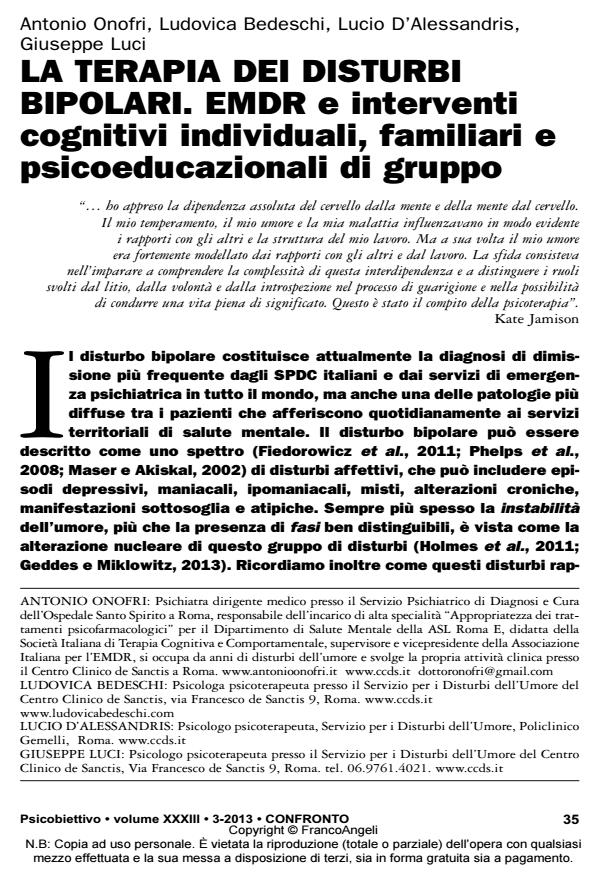La terapia dei disturbi bipolari. EMDR e interventi cognitivi individuali, familiari e psicoeducazionali di gruppo
Journal title PSICOBIETTIVO
Author/s Antonio Onofri, Ludovica Bedeschi, Lucio D'Alessandris, Giuseppe Luci
Publishing Year 2014 Issue 2013/3
Language Italian Pages 20 P. 35-54 File size 176 KB
DOI 10.3280/PSOB2013-003003
DOI is like a bar code for intellectual property: to have more infomation
click here
Below, you can see the article first page
If you want to buy this article in PDF format, you can do it, following the instructions to buy download credits

FrancoAngeli is member of Publishers International Linking Association, Inc (PILA), a not-for-profit association which run the CrossRef service enabling links to and from online scholarly content.
The Authors remind the importance of the evidence based interventions able to significantly reduce the rate of relapses and hospitalizations in Bipolar Disorders. They remember the role of the psychoeducational therapy and of the information given to the patients and their relatives. The cognitive therapy can be used to reduce the stress, to help the patients to better adhere the pharmacotherapy, to keep on working, studying and social activities, to be more able to start and maintain a romantic relationship and affectionate bonds with the relatives, acting on the pathogenic beliefs that the patients have about their illness and the drug therapy. The main goals of the cognitive-behavioural therapy are: use cognitive abilities to reduce the emotional instability and the impulsive behaviors; increase optimistic attitudes and reduce the risk of committing suicide; think about the pros and the contras of the important life decisions; modify the perception of the marriage and family interactions; reduce the stigma and the shame. Then, the Authors remind the importance of some recent clinical research that used the EMDR and showed significant results in reducing the impact of the traumas (so frequent in the autobiographical history of the bipolar patients) and also in improving and stabilizing the mood in a sample of bipolar patients. This effect could be explained by the regulating action of the EMDR on the Default Mode Network. After this, the Authors present the Family Focused Cognitive Treatment proposed by Miklowitz and, at last, an interesting model of a new Integrative Group Therapy.
Keywords: Bipolar Disorders; Cognitive-Behavioral Therapy; EMDR; Psychoeducational Groups; Family-Focused Cognitive Treatment; Therapeutic Groups
Antonio Onofri, Ludovica Bedeschi, Lucio D'Alessandris, Giuseppe Luci, La terapia dei disturbi bipolari. EMDR e interventi cognitivi individuali, familiari e psicoeducazionali di gruppo in "PSICOBIETTIVO" 3/2013, pp 35-54, DOI: 10.3280/PSOB2013-003003